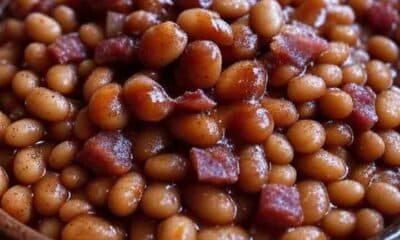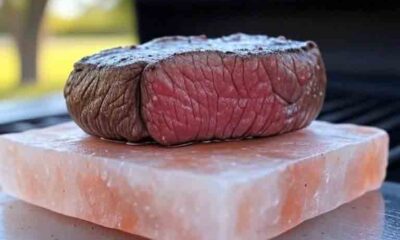Grilling Academy
Deli Meats: Enjoy Your Deli-ghtful Guide to Beefy Slices Now
Well, howdy there, meat lovers! Travis “Smoke Daddy” Wheeler here, comin’ at ya from Franklin, Tennessee, where the smoke’s thick and the brisket’s thicker. Don’t think of deli meats ast just some fancy city grub—instead, picture them as a downright versatile bunch. Why, there’s pastrami, roast beef, brisket, and corned beef. Each one’s got its own smoky soul, so let’s fire up this guide and dig into what makes ‘em special.
Deli Meats Recipes: Pastrami Prep
Preparation of Pastrami
Pastrami’s born from beef brisket or plate, and it’s got roots deep in Eastern Europe with a nod to Turkish know-how. Jewish immigrants hauled it over to the U.S., and I thank the smoke gods they did. Here’s how it gets that hickory-kissed magic.
Curing: First off, we dunk that brisket in a brine bath—salt, sugar, and a fistful of spices like garlic, coriander, and black pepper. It’s that salty soak that sets the stage.
Rubbing: Then, we slap on a spice rub thicker than a Tennessee fog. Pepper, coriander, mustard seeds—they crust up that meat like nobody’s business, givin’ it that signature bite.
Smoking: Next, it’s low-and-slow time. We smoke it for hours over hickory or cherry wood, lettin’ that smoke ring sink in deep, because it keeps it tender and packs in the flavor.
Steaming: Finally, a good steam locks in that moist, melt-in-your-mouth texture. After all, ain’t no dry pastrami on my watch.
Flavor and Texture of Pastrami
Pastrami’s got a bold, smoky punch with a peppery kick that’ll wake your taste buds right up. The texture’s tender, but if you hit a tougher cut, it’ll chew like a champ.
Serving: Stack it high on rye with a smear of mustard—hot or cold, it’s a winner. Throw some pickles on the side, and you’re livin’ large.
Cultural Significance: This stuff’s a legend in Jewish delis, ‘specially up in New York City. It’s more than meat—it’s heritage, smoked and spiced through the ages. Plus, that flavor’s tougher than a two-dollar steak.
Make Pastrami at home – https://ruhlman.com/homemade-pastrami/
Roast Beef for Deli Meats Lovers
Preparation of Roast Beef
Roast beef’s a straight shooter—cuts like eye of round, top round, or sirloin tip bring different vibes to the table. Therefore, tenderness and flavor depend on how you treat ‘em.
Seasoning: First, hit it with salt and pepper. Wanna get fancy? Toss in some rosemary or thyme—keeps it simple but tasty.
Curing: Nope, no curing here. Unlike other deli meats, this ain’t no brine-soaked affair.
Roasting: Crank the heat high to sear that crust, then drop it low for even cookin’. Aim for medium-rare to medium—after all, juicy’s the name of the game.
Resting: After, let it sit. Lettin’ those juices settle in, makes every bite drip with goodness.
Slicing: Thin slices, folks—that’s how you stack a sandwich right, especially for deli fans.
Flavor and Texture of Roast Beef
Roast beef’s all about that pure, beefy taste. Spices can jazz it up, and roastin’ gives it a caramelized edge. Cut thin, it’s tender as all get-out, even cold.
You can rub it with garlic and herbs or toss it in the smoker for a smoky twist—your call.
Serving: Slap it on a sandwich with horseradish sauce, mustard, and cheese. Alternatively, let it shine on a charcuterie board. Simple, but it holds its own.
Want to make roast beef? This might help – https://www.fromvalerieskitchen.com/deli-style-roast-beef/
Brisket: A Deli Meats Staple
Preparation of Brisket
Brisket’s from the cow’s lower chest—tough as nails ‘cause that muscle’s been workin’ overtime. However, cook it right, and it’s deli gold.
Seasoning: Start with salt and pepper. But, every deli’s got its own secret spice mix—keeps things interestin’.
Cooking: Low and slow’s the trick. Braise it, smoke it, or roast it—hours of heat turn that toughness into velvet, thus makin’ it a standout.
Slicing: Cool it down, then slice it thin. That’s where the tenderness shines through.
Flavor and Texture of Brisket
Cooked right, brisket’s tender enough to melt in your mouth. However, lean bits might fight back a little, but that’s just character.
Serving: Load it on rye with mustard and pickles, or let it star on a deli platter. Also, you can toss it on a salad if you’re feelin’ wild.
Flavor Profile: Smoked brisket’s got that deep, wood-fired taste. Braised? Savory as all heck. Meanwhile, roasted keeps it straight-up beefy.
Cultural Variations:
Jewish Deli: Garlic and paprika, then braise it slow.
Southern BBQ: Dry rub or mop sauce, smoked ‘til it sings.
Brisket’s a labor of love—long cookin’ for big flavor. Sandwiches, feasts, you name it—it’s comfort on a plate.
Check out this Pastrami Style Brisket – https://popularbbq.com/pastrami-style-brisket/
Corned Beef: A Deli Meats Classic
Preparation of Corned Beef
Corned beef’s all about that salt-cured life—big ol’ salt grains gave it the name. However, Irish and Jewish folks made it a legend.
Curing: Soak that beef in brine—water, salt, sugar, and spices like mustard seeds, peppercorns, and coriander. It takes days, but it’s worth it.
Boiling or Simmering: Next, simmer it slow for hours—tenderizin’ it for classics like corned beef and cabbage.
Baking or Roasting: Sometimes, bake it after boilin’ for a crusty finish, because texture matters.
Slicing: Finally, slice against the grain, thin as you can. Consequently, it stays soft and sandwich-ready.
Flavor and Texture of Corned Beef
That curing gives it a salty, savory kick and that pink hue from the salts. Afterward, cooked up, it’s tender with a beefy backbone.
A thread about corned beef you may be interested in – https://www.smokingmeatforums.com/threads/corned-beef-recipe.329390/
Cultural Significance of Corned Beef
Irish-American: Corned beef and cabbage? That’s St. Paddy’s Day grub stateside—Irish immigrants kicked it off. In contrast, back in Ireland, it’s more bacon and cabbage.
Jewish Deli: Steamed and sliced, it’s a rye-and-mustard king in delis everywhere.
Corned beef’s a cold-weather hero—rich, hearty, and ready to party on your plate.
Similarities and Differences Among Deli Meats
All these bad boys start with beef, however, pastrami and corned beef get the curing treatment, while roast beef and brisket might skip it. Curing’s where the flavor and shelf-life magic happens. Pastrami and corned beef lean on brining and steaming or boiling, but brisket and roast beef? They’re all about that roast or smoke life.
Flavor Profiles of Deli Meats
Pastrami hits with smoky spice.
Roast Beef keeps it real with straight beef vibes.
Brisket swings from smoky BBQ to savory braise.
Corned Beef brings salty spice to the table.
Summary of Deli Meats
Deli meats like pastrami, roast beef, brisket, and corned beef are your go-to for sandwiches and platters. Each one’s got its own tricks and traditions. Pastrami and corned beef rule the deli scene, while roast beef’s your all-purpose player. Meanwhile, brisket’s a BBQ and Jewish cuisine heavyweight. Knowin’ these cuts opens up a world of smoky, beefy fun. Therefore, whether it’s pastrami on rye, roast beef for supper, or brisket at a shindig, they’re tradition you can taste.
What’s your favorite way to enjoy deli meats? Share your tips in the comments below!
















